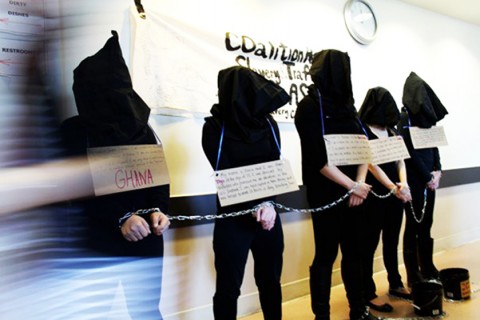Kimberly Vecchione’s daughter Cassie was an outstanding student, athlete, musician and artist before she met Carl. Carl talked her into trying heroin, and when she became addicted, he got her so doped up that she didn’t know she was chained to a bed. Against her will, he made her start performing sexual acts for money. He was selling her.
Vecchione, of Trumbull, CT, worked with the local police department and Frank Barnaba of the Barnaba Institute to find her daughter and other girls like her. They found Cassie, but she relapsed and continued to return to Carl, who loaded her with heroin and put her out on the streets again. Sadly, Cassie passed away in 2007, but her mother still works to help other girls in similar situations.
On April 22, students in the Charles Chu Room listened as Vecchione and Barnaba related the truth about slavery: it still exists, and it happens here in Connecticut. Many people fail to realize this because prostitution, drugs and trafficking are all, as Vecchione put it, “dirty little words” with huge stigmas attached. Jokes are made about prostitutes that they’re “just sex fiends,” when in reality, they are being exploited.
The Barnaba Institute in Clinton, CT, provides support services for victims. The Institute started with a grant from President Reagan, though funding for the Institute has stopped since 9/11, as the money is now used for Homeland Security.
Frank Barnaba works with the FBI and local police departments to go out on the streets and work one-on-one with sex trafficking victims. According to Barnaba, “the average age of entry into prostitution has just been lowered to twelve years old.” He’s worked with victims from all walks of life, from a five-year-old boy in Vegas to twenty-somethings in New York. He’s gained their trust by loving them and showing them kindness, and, in doing so, has been able to help them escape and restart their lives.
According to Vecchione and Barnaba, one thing that hinders victims from escaping the lifestyle is Connecticut legislation surrounding drug rehab centers. A person must be using drugs at the time of admission to be admitted to a rehab center. A person who has stopped using on their own will not be admitted, even if they have only been “clean” for three days. Also, a user must leave the rehab center after 30 days. Because they only have 30 days to work to undo years of a lifestyle, many victims return to their lifestyle of using drugs and selling their body.
According to HumanTrafficking.org, an estimated 17,500 people each year are trafficked into the United States, mostly for labor purposes. However, under one percent of cases are prosecuted. Because this percentage is so small, there is a tendency to overlook this as a major problem, when in reality the statistics only show the tip of the iceberg. When it comes to sex trafficking, the victims are often arrested and prosecuted for prostitution while the pimps, who would be prosecuted for trafficking, go free. Last year, Connecticut passed the Safe Harbor Act, which prevents minors from being prosecuted for prostitution. While this is progress, victims services programs like the Barnaba Institute are underfunded and victims are not receiving the help they need.
Trafficking is not just something that only happens overseas. In January 2011, a thirty-one-year-old man from New Britain, CT pleaded guilty to trafficking, which is a class B felony in Connecticut as of 2006. He had recruited two fourteen-year-old girls to work as prostitutes in hotels in Hartford and East Hartford.
Trafficking is extremely prevalent in New London. According to Janet Tso ’12, a co-president of CoAST, New London “is one of the main cities on the Nation Tour, which is essentially a map used by traffickers to transport sex slaves along the Eastern United States.” Pimps drop their girls off at the New London Meal Center on Montawk Ave. for free food, where the Barnaba Institute can identify and meet victims when they are moved to other cities in the area like Hartford, New Haven, and Providence. The Crystal Mall is also a hotspot for trafficking, as it is a public place to find victims and is on the I-95 corridor. Students need to be aware that traffickers are in our own neighborhoods, and should note if anything looks suspicious. •









